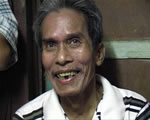 Master Lisondra was born 1946. He was a very early student and later instructor under Professor Remy Presas. Master Bebing Lisondra and his brother Rudolfo “Rudy” Lisondra received Black belt in Modern Arnis in December 11, 1964 at San Agustin University, in Iloilo. They were the first Arnisadors ever, who received their black belt from Professor Remy Presas. Master Lisondra received Lakan Apat, 4th Dan from the Professor in 1970. Master Lisondra was born 1946. He was a very early student and later instructor under Professor Remy Presas. Master Bebing Lisondra and his brother Rudolfo “Rudy” Lisondra received Black belt in Modern Arnis in December 11, 1964 at San Agustin University, in Iloilo. They were the first Arnisadors ever, who received their black belt from Professor Remy Presas. Master Lisondra received Lakan Apat, 4th Dan from the Professor in 1970.
His brother, was the 1st to partner Grandmaster Remy sparring with the live Machete/Bolo at University of San Agustin Gym at Iloilo City December 1964.
Master Bibing Lisondra was the first Martial Arts teacher of SM Samuel “Bambit” Dulay. To do this interview, I visited him in his house on the evening of the 23rd of July 2006 together with Grandmaster Rene Tongson, Grandmaster Cristino Vasquez, Senior Master Bambit Dulay and several others who helped during the interview, like his son, who did some of the translation, when Master Lisondra said something in Ilonggo, that I could not understand. But mainly the interview was held in english. Due to a grey star his is blind and soon to be operated on both eyes, if he has the funds.
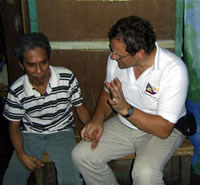
Dieter Knuettel during interview with Romy “Bebing” Lisondra.
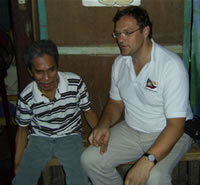 |
Dieter Knuettel (DK): When did you start to learn Arnis under GM Remy?
“Bibing” Lisondra (BL): I started in 1958. But I started with Judo in 1954 at the age of 8 years then I shifted to Arnis in 1958.Then I became an assistand instructor under Remy Presas in 1968. In the middle of 69/70, Remy transferred to Manila. He left me alone to teach Arnis at the UNOR (University of Negros Occidental).
Then Mr. Presas hired me to go to Manila to assist again in his Arnis. This was under the name of NAKO, the “National Amateur Karate Organisation”.
And then 1971 before the martial law I am going back to Bacolod. Remy Presas stayed in Manila. Some years later I heard Professor Presas going abroad.
DK: When did he start to call it Modern Arnis?
If I am not mistaken, in 1968 something like that. But I cannot remember. (A big discussion in Ilonggo followed between Master Lisondra and GM Rene Tongson and GM Cristino Vasquez)
Grandmaster Rene Tongson (RT): He cannot recall. Because the problem before, most people was doing Arnis with Remy Presas, but would not know that it would be called Modern Arnis later.
BL: Yes.
DK: What techniques did you practise with him? Did you do single stick, Espada y Daga, doublestick, Sinawali what did he teach by that time?
BL: Double Sinawali, double stick. Double stick and… because the sinawali, that is the old name. But the Arnis it was called Baston and not Arnis. And the arnis in this time the Tapi-Tapi was called Corridas. (Ilonggo discussion again) It was dikititan, close quarter. Defense and offense, close fighting.
DK: Were there already done disarming techiques at that time or more striking or Sinawali. What were the main things that were trained at that time?
BL: Disarming? No. Before the fundamentals, and then the basics
DK: What did the fundamentals and basics consist of?
BL: Fundamentals and Sinawali. Fundamental form of Arnis. Stances, blocking like that. defense and offense.
DK: Was it mainly single stick then?
BL: Single and double.
DK: Did you do knife as well in those days and Espada y Daga?
BL: Doublestick, long.
DK: How about knife defense?
BL: Knife defense is combative style. That is part of Jujitsu. And disarming tactics of disarming the knife.
DK: How many student did Professor Presas have, when he was teaching here at UNOR or at his club?
BL: At the start there were only few. If I am not mistaken it was only 10. My brother Rudy, me, Mr. Presas, 2 brothers Doromal, Rologo, Nelson Canada. More I cannot remember the others.
DK: Was that at the beginning of the University here?
BL: No, no, before. That was at the beginning at his club.
DK: Later, when he left to Manila, in 1968 or 1969, did that increase? Did he have many more students then?
BL: Plenty, plenty of students. Besides the university. These were not a member of the students, of the university. There you only took it as physical education or as combative sports. In the gym only that is qualified as a member. In the gym almost 50 to 80 students. Exept the privates.
DK: When did he start to use the belts as ranking system? Was this already in Bacolod or only in Manila?
BL: In Bacolod.
DK: Did he use different colour belts and Lakan for the black belts?
BL: No, no. Here in Bacolod it was not for the Lakan. The belting was only for the colour. Colour coding only. He adapts the Lakan grading only in Manila. I can remember.
DK: So you went through the student levels and then you were instructor, or how was that?
BL: Of course
DK: How long would it take at these times, when you begin to become an instructor? Would it be one or five years?
BL: As an assistant instructor of Professor Presas, I call him Professor, I started in Arnis in 1958 and was instructor in 1968.
DK: So you started in 68 to become an instructor and before you were only a student right?
Again a discussion in Ilonggo and then his son explained: Before he was officially considered an instructor, he already assisted Professor Presas.
DK: So when did you start to assist Professor Presas in the teaching?
BL: That was 1962. But this was not in Arnis only, but also in Karate. Before doing Arnis I was doing Karate. Also tournaments.
DK: Were there also Arnis tournaments here in Bacolod at that time?
BL: No, not yet.
DK: Were there challenges? Were other masters coming to Remy to challenge him?
BL: Oh yes, plenty. Doromal is one of the base instructors here in Bacolod. He was a Col. Commander at the Negros College, ROTC. Mr. Presas was only demonstrating his Arnis. But Mr. Doromal challenged first, before Mr. Presas’ demo. And then Mr. Doromal looses against Mr. Presas. So that was the first challenge at that time.
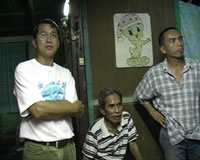
Grandmaster Tongson, Master Lisondra and his son.
|
Mr. Lisondras’ son explained, that Mr. Doromal was considered as one of the best fighters in Bacolod at that time. So Mr. Presas beat him and that was the time, when Mr. Doromal became one for the first members of Mr. Presas club. Everybody laughed and somebody said: if you can’t beat them, join them.
DK: What style did Mr. Doromal come from? What did he study before he learned with Professor Presas?
BL: I don’ t know.
Everybody talking. Someone said: at that time, no numbers, no styles. It was called Wedo: We do this and we do that.
RT: Because before, there were no names. It was only systematized during Remy Presas’ research already. That was the time, when they called it Modern Arnis. It was already systematized; it was already numbered.
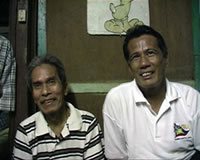
Master Lisondra and
Grandmaster Vasquez |
DK: So that was when he was already in Manila, end of the 60s?
GM Cristino Vasquez (CV): He moved in 68.
DK: You followed him to Manila. Did his teaching change from the time he taught you end of the 50s to beginning of the 70s, when you returned from Manila to Bacolod?
BL: Yes, there were changes.
DK: What happened? What was different?
BL: There was many. Tapi-Tapi, disarming, so many. From traditional to Modern to his own style.
DK: Was it a stick-oriented art or was it a blade oriented art what he taught.
BL: Stick and blade.
RT: There was no difference between stick and blade. Anything you hold is a weapon. That is why we wanted to remove that concept especially in western area, even in Europe.
If it is a stick or a blade, it is still a weapon. Sometimes there are students who say: “What if I do this I will cut here” So I ask “what are you holding” “A stick” “Well that’s a stick. You can not cut with a stick.” When you hold a blade it is a blade. When you hold a stick it is a stick. We have to remove this concept. If you hold a stick or a blade, it is a weapon.
DK: The question was did he teach also: now we do Bolo or now we do blade?
RT: We were instructed that we started to teach the blade because it was already the combat method.
DK: Was the training more oriented to stickfighting, or self-defense or more military orientated?
BL: Stick and then combat. He was teaching the army during this time, during martial law.
DK: Was there also empty hand techniques involved, or Dulo-Dulo for example.
BL: Yes.
DK: The teaching in the 70s in Manila, did that gear more towards education compared the combative modes that he had before? Did he change the way of teaching because he was teaching students compared to teaching soldiers?
BL: Yes educational. Purely educational at the universities. The combative was exclusively at the gym.
DK: So at university he was teaching more fundamentals and basics probably
BL: Yes
DK: And when he went to his dojo he was teaching more advanced techniques, more combat oriented techniques?
BL: Combative and self-defense.
DK: Did he tell from what teacher he got his techniques? Like from his father, his grandfather etc.
BL: No, he did not say.
DK: Were his brothers involved in the teaching or in the Dojo as well, Ernesto or Roberto? Were there as well?
BL: Ernesto was more a runner, track and field, walkathon.
DK: Were there different stick used in challenge fights compared to training? Like other wood, Bahi or Kamagong, where they flat instead of round, yantoks?
BL: Challenge fights? Kamagong. And Bahi
DK: Ah that’s nice and in training?
BL: In training, it’s only Rattan.
RT: But in fighting Kamagong or Bahi.
DK: Did they use round stick or flat sticks?
BL: Round.
DK: How long did the fights last. Was it a thing of 10 seconds or of several minutes?
BL: It was only a thing of bang bang bang. Not 5 seconds.
DK: Well with bahi or Kamagong sticks I can understand that. And Remy was of course fighting left-handed.
BL: Left, yes.
DK: That was not fair
Laughter.
BL: He can fight left and right. His main was the left, but he could also fight with the right.
DK: But it was single stick fighting right?
BL: Single stick.
DK: What were the rules of the fight. When was the fight finishes? When one was on the ground, when one runs away?
BL: No rules, just fight to the finish
DK: When did you know the fight was finished?
BL: When the other one surrendered. When the opponent says “I give up” then it is finished.
DK: So physical condition was not really important, when the fight only lasts for 5 seconds.
CV: When Professor Remy fought an opponent with single stick who was using Espada y Daga. He disarmed the Daga and the Espada and said to his opponent: “With only a broomstick I can disarm you.” He really had fighting spirit.
BL: Yes he had heart and fighting spirit.
RT: When Mr. Yanson from the Bacolod, who was very well known stickfighter at that time, lost against Remy in the late 50s, he gave him all his students. He even send his son to study under Remy. So he even surrendered his son.
BL: Bambit (Dulay) started martial arts under me. He studied Karate, Judo and other arts, and when I left Manila back to Bacolod, I endorsed Bambit to Remy and Ernesto. He is very good in martial arts; you just have to polish his Arnis (laughter).
DK: Well, they did.
RT: That was long time ago.
DK: Did Professor Remy teach Sinawali already in the beginning? In the 50s and 60s or when did he start wit is?
BL: Double Sinawali yes. 6 strike standard double sinawali. From the beginning.
DK: Where did the Double sinawali come from?
RT: We don’t know. He just came out with it and teach it.
DK: Do you remember, when the Single Sinawali came in?
BL: I cannot remember.
DK: How long was the training in those times? Was it an hour or 1 ½?
BL: In those times it was almost 3 to 4 hours.
DK: Was it very few techniques with high repetition?
BL: Just a few techniques. He would only give 3 to 4 techniques and then it would perhaps take a month, until he taught a new technique.
DK: How often would you train a week with him?
BL: Daily.
DK: Daily 3 – 4 hours, wow.
RT: Later, when he was not living in Bacolod any more, he gave you a technique and you had to work one month at this technique and then he might give you an new one, if he remembered to call you when he was in town. So sometimes it was 2 months before you learned a new technique. So by the time we moved to another technique, it was already very very polished. It’s perfection. Not quantity.
DK: So it was quality not quantity. Were there formal examinations for a belt or would he just say now you are the next level.
BL: When he sees you are good he would say, “yes you are good” No formal exams during that time.
DK: When you trained with him in the beginning, were the blocks done on the arm or the hand or on the sticks.
BL: To the sticks.
DK: Was there grabbing the sticks of the opponent well.
BL: Yes, grabbing the stick.
DK: That’s interesting.
CV: The secret of Modern Arnis is grabbing.
RT: When he made contact, you could not move any more. When he grabbed you, you could not go away. He had control. So that is the secret there.
DK: Were there other styles jealous of the success that he had with his style?
BL: Yes, that is natural.
DK: Were there a lot of injuries in the training at that time? In the early days?
BL: We only had one accident one time. Then only a lot of bruises.
DK: What was so special about the Professor at that time that the people wanted to join him and to learn from him?
BL: It was his style and his techniques what attracted the people. Very effective.
DK: Dr. Lengson and Master Chiuten was before?
RT: No that was already in Manila. That was already named Modern Arnis.
DK: That is interesting. Because in the US there is a discussion, that Remy got his Sinawali from Dr. Lengson.
RT: Wrong wrong
DK: But when Master Lisondra already trained Sinawali in 1958 with the Professor that is wrong then.
RT: In these days there was only Double Sinawali, No Single.
DK: When did he train with Dr. Lengson?
RT: That was already in Manila. It was a few years before Rodel. Dr. Lengson and the Professor were training partners. They were doing television programs at that time. Double Sinawali was very spectacular in the Television, especially when it was done very fast.
But for us, Double Sinawali is the a basic technique. But it is very effective as a basic. It is already a fighting technique. In the time when they were doing it in Manila it was for the purpose of television production.
RT: He did the drawing for the Modern Arnis book.
BL: I drew that. The first volume from Presas
DK: The pink book?
BL: Oh yea, the illustration.
DK: Wow, so you were the artist who drew it.
BL: I drew that in 1968 during the instruction in UNOR, in the University.
DK: So the first book was prepared, when he was still teaching in Bacolod, right?
BL: Yes
DK: When was it first issued?
Discussion in Ilonggo and then his son said, that he couldn’t remember.
DK: Was the book published before he trained with Dr. Lengson?
Discussion again. Nobody knew exactly, but it was assumed, that Dr. Lengson started with the Professor around 1970.
DK: When did Professor Remy start using uniforms?
BL: 1968 at UNOR. It was red pants and white t-shirt. That’s the original uniform.
DK: Was that also the time when he started using the belts? The black belts or the Lakans? When he started to use the uniforms?
BL: Not yet. There were gradings but not yet a lakan.
DK:But in the book it was already.
BL: It started when he was in Manila.
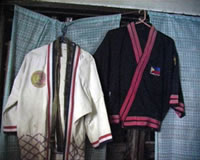
Master Lisondras Karate Arnis uniforms. |
DK: I see over there your bolero of your Arnis uniform hanging there. When was the bolero introduced for the Arnis uniform? In the 70s?
RT: No, no, it was already Modern Arnis then. It was only white t-shirt and red pants. Before there was no elastic waistband. Now it is easy, you only put it on. But before you had to tie it.
DK: The red pants and the white t-shirt came from the Katipuneros?
RT: Basically it was the filipino fighters before, the freedom fighters. They used the red and white. Only red pants and t-shirt. Very standard.
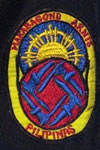
Master Lisondras Arnis uniform patch |
DK: Thank you very much for your time and for all the answers you gave me. I wish you all the best for your operation on your eyes.
Salamat po.
Senior Master Dieter Knüttel began his Arnis Training in 1978. Eh holds Lakan Pito, 7th Dan Modern Arnis and is one of the 6 Arnisadores, who received the Datu title from Professor Remy Presas. He lives and instructs in Germany but teaches Modern Arnis also in seminars all over the world.
Return to Top |